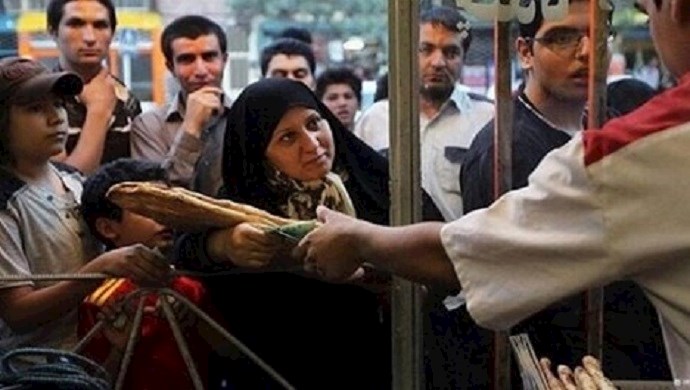Reporting by PMOI/MEK
Iran, October 25, 2020—One of the characteristics of autumn in Iran is the shortage of bread supply and its skyrocketin5 price.
The first news reports of this year’s bread shortage and its high prices came from Khuzestan province, southwest of Iran, and then several reports were seen from other parts of the country.
In some areas, there is no bread shortage, but the price has increased considerably. In a major city like Tabriz, northwest of Iran, the price of bread has increased by 30 to 50 percent.
In some cities, many bakeries have closed due to lack of flour, while in other cities, bread can be bought in limited quantities after people stay hours in line.
On Friday October 2, in the city of Mahdasht, a single loaf of “Sangak” bread reached 20,000 rials, while two days ago it was 11,000 rials.
The bread shortage in the city of Urmia, northwest of Iran, has reached such a level that some people even sell 10 loaves of bread at 100,000 rials using the “Divar” mobile app.
October 24 – Shahriar, near Tehran, #Iran
Reports indicate bakeries have closed down in this city due to a severe flour shortage. No officials are responding to the locals’ complaints.#41YearsOfMisery pic.twitter.com/qXPLymOpob— People’s Mojahedin Organization of Iran (PMOI/MEK) (@Mojahedineng) October 24, 2020
Is there a shortage of wheat?
The Deputy Minister of Agriculture told the IRNA news agency on May 28, 2019, that Iran was self-sufficient in wheat production for the fourth consecutive year.
“Farmers did not sell their crops (wheat) to the government due to the low guaranteed purchase rate,” according to the Deputy Minister of Agriculture cited by the Tejarat News website on December 22, 2019.
“This year, the country’s wheat production will be purchased from farmers with a guarantee and a four percent discount,” said Ismail Esfandiaripour, an advisor to the Agriculture Minister and head of the Wheat Project in an interview with the IANA news agency, in East Azerbaijan province, northwest Iran, on May 19, 2020.
“We currently have 14 million tons of wheat stored in the country. This is while our annual consumption is 12 million tons. The is a problem in the distribution system,” said Jabbar Kouchaki-Nejad, a member of the Majlis (parliament) from the city of Rasht, north of Iran, on October 4, according to Ghalat News.
A glance at a few facts
“We are not facing a shortage of bread. The reason for the delay is the delivery of flour to bakeries,” said the head of the Traditional Bread Union on October 16, according to the semi-official ILNA news agency.
“A shipping company that specializes in transporting flour to bakeries says shipping rates are low and for this reason, it was negligent in transporting flour. And with the increase in prices the problem was resolved and it was decided to deliver the flour to the bakeries on time. This company is responsible for transporting flour to about 15 provinces, including Tehran. The fare that was given to transfer each bag of flour from Tehran factories to bakeries was 15,000 rials, which increased to 22,000 rials, and the fare for transporting flour from the city of Karaj, west of Tehran, to factories in Tehran has increased to 25,000 rials,” he continued.
Since the beginning of 2020, expenses of bakeries, including workers’ wages, have risen. Sixty to 70 percent of the cost of bread is due to wages. Insurance, taxes, water, electricity, gas and the costs imposed by Covid-19 (sanitizer, gloves, etc.) all lead to increasing costs for bakeries,” he added.
“Bread consumption has increased because this city is in a working-class area,” says one bakery worker in the city of Neka, north of Iran.
“People’s consumption has not changed, but the flour quota has decreased, and its price has increased by 70 percent. We used to purchase flour from the free market and the price of flour was 900,000 rials for each bag. Now the price is 1.3-1.4 million rials per bag,” said another baker in the city of Saqqez, west of Iran.
Conclusions
At first glance, the facts might imply that the regime is not to blame for the shortage and high costs of bread. However, when we pay attention to the interviews of regime officials about the preparation and distribution of wheat, flour and bread, another reality emerges that shows the depth of a scam.
The mullahs have increased the price of fuel, transportation, yeast dough, insurance, water, electricity, taxes, etc., and they still claim that bread has not become more expensive. These are all major factors in increasing the price of bread and other staple foods.
Former Iranian regime president Mahmoud Ahmadinejad started the first stage of reducing subsidies in December 2010 by paying a mere 450,000 rials (about $34.50 in December 2010) in cash subsidies to the people.
Today, the value of that 450,000 rials has dropped to $1.5. But the amount of cash subsidies has not been adjusted according to the devaluation of the national currency. As a result, bread became more expensive from the day that public subsidies were cut and a cash subsidy of 450,000 rials replaced it.
“Bread and cereals are 52.6 percent more expensive than last year. Villagers have witnessed a 58.9 percent increase in the prices bread and cereals in October 2020, and a 50.7 percent increase for urban families compared to October 2019,” according to an October 23 report by the Statistical Centre of Iran.
While the lives of the Iranian people continue to spiral into poverty and misery, the regime has done nothing to help them. Meanwhile, there seems to be no shortage of resources to fund weapons-building programs, nuclear projects, terrorist adventures and other illicit behavior that have become the hallmark of the mullahs’ rule in Iran.





